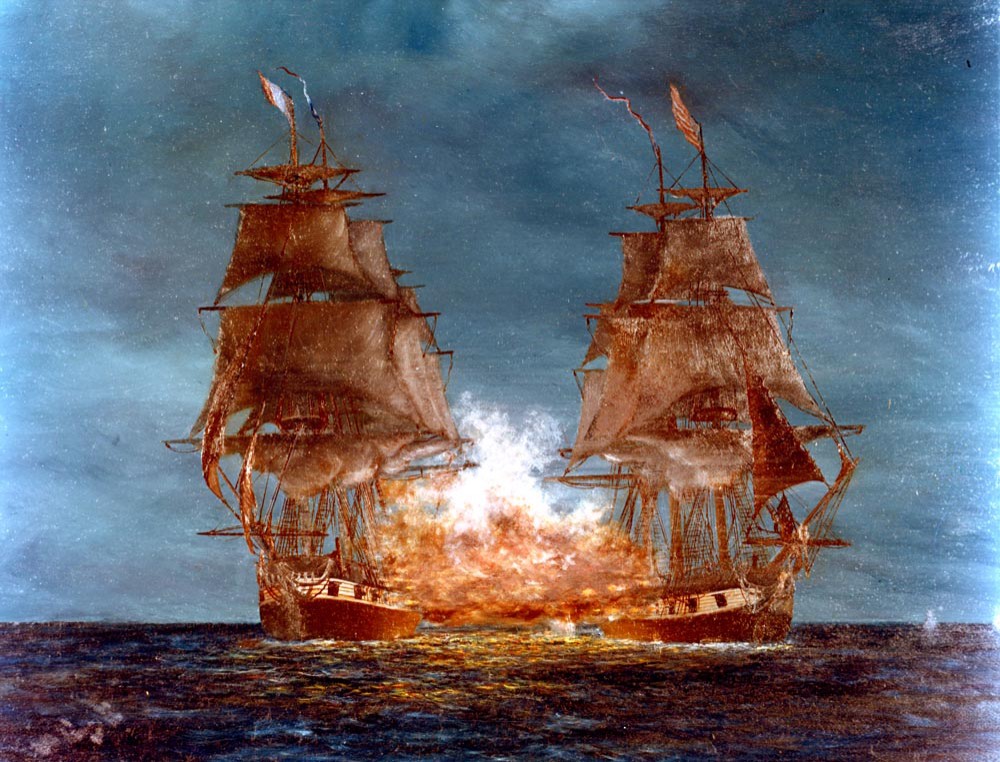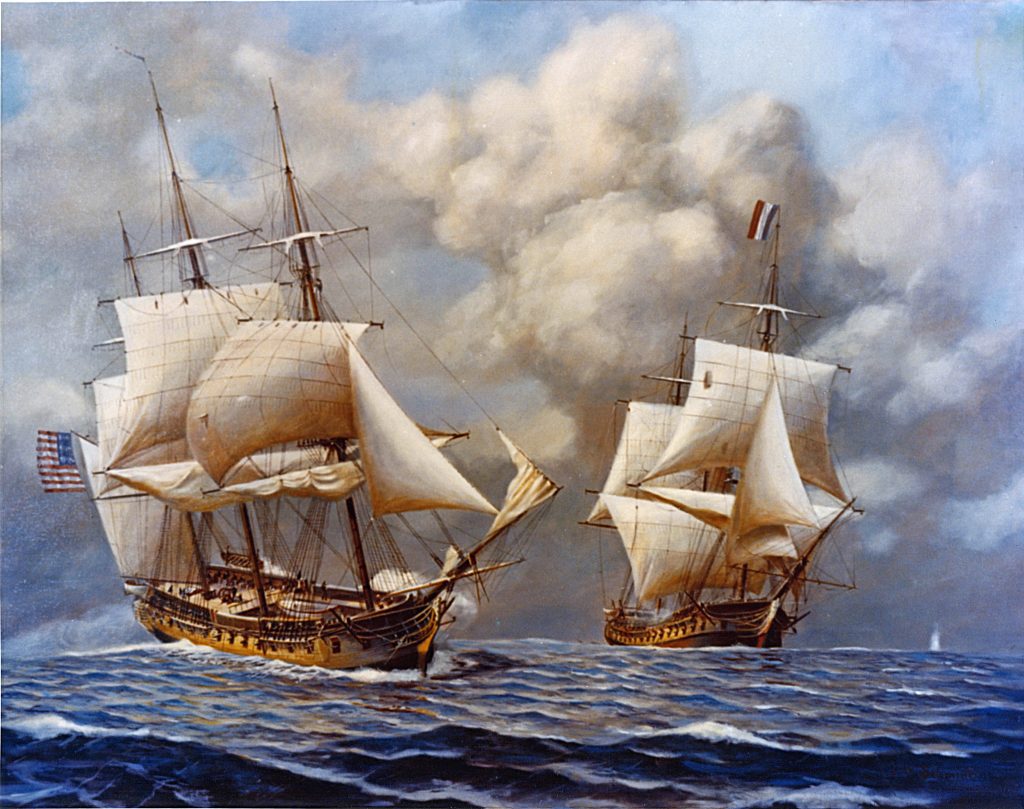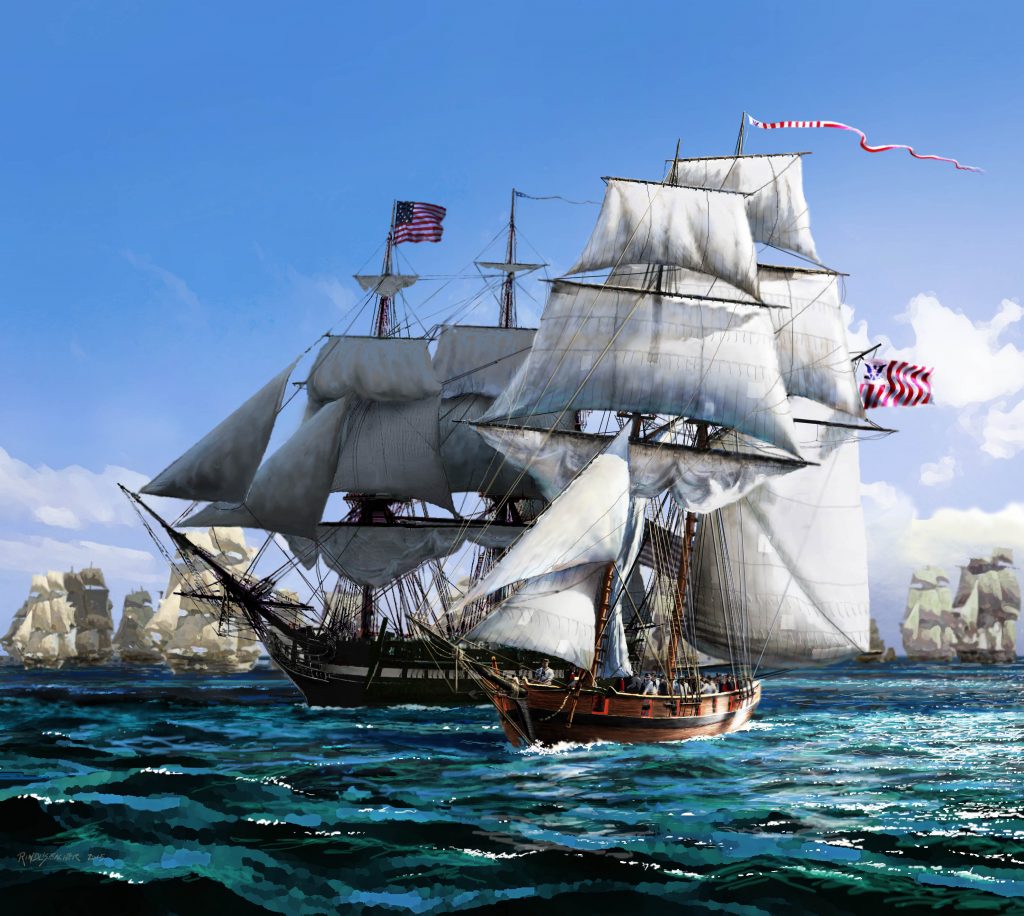| Quasi-War |
| Undeclared naval war between the US and French First Republic |
| Duration | July 7, 1798 – September 30, 1800 |
| Location | Atlantic Ocean, Caribbean, Indian Ocean, Mediterranean Sea |
| Primary Cause | Dispute over French loans and different interpretations of treaties between the US and France |



The Quasi-War (1798-1800) was an undeclared naval conflict between the United States and France, primarily fought in the Caribbean Sea and along the eastern coast of the United States. Here is the story of this maritime confrontation:
Origins and Causes
After the American Revolutionary War, tensions arose between the U.S. and France due to differing interpretations of the 1778 Treaty of Alliance. France, engaged in the French Revolutionary Wars against Britain, expected American support based on the treaty. However, the U.S. under President George Washington maintained a policy of neutrality, angering the French.Matters escalated when the U.S. signed the Jay Treaty with Britain in 1794, which the French viewed as incompatible with the alliance. In retaliation, French privateers began seizing American merchant ships trading with Britain from 1796 onwards.
Outbreak of Naval Hostilities
By October 1797, over 300 American merchant ships had been captured by the French. In response, the U.S. Congress, under President John Adams, approved the creation of the U.S. Navy Department in 1798 and authorized naval defense against French attacks.The newly formed U.S. Navy, consisting of converted merchant ships and the first few frigates like USS Constitution, engaged French privateers and warships in the Caribbean. Notable actions included the capture of the French privateers L’Insurgente and La Vengeance by USS Constellation.
Unofficial Alliance with Britain
Although not an official ally, the U.S. Navy informally cooperated with the British Royal Navy in the Caribbean by joining convoys and sharing intelligence. This helped reduce American shipping losses against the French privateers.
Resolution and Consequences
Diplomatic negotiations between the U.S. and France continued, leading to the Convention of 1800 (Treaty of Mortefontaine) which ended the naval conflict. The Quasi-War affirmed U.S. neutrality and its right to free trade, while also establishing the U.S. Navy as a credible naval force.The ability of Congress to authorize military force without a formal war declaration was upheld by the Supreme Court, setting a precedent for future “undeclared wars” like the Vietnam War.While limited in scope, the Quasi-War marked the U.S. Navy’s first major test and demonstrated the young nation’s willingness to defend its maritime rights through naval force against a former ally. It paved the way for the U.S. to emerge as a naval power in the 19th century.
The key battles during the Quasi-War

The key battles during the Quasi-War between the United States and France from 1798-1800 were:
- Capture of the French Privateer Retaliation (1798)
This was one of the first major actions after the U.S. authorized naval operations against French privateers and merchant vessels in July 1798. The USS Constellation captured the French privateer Retaliation in November 1798. - Battle of the Basque Roads (1809)
This was one of the largest naval engagements of the Quasi-War. In April 1809, a squadron of French warships under Captain Bourde attempted to break out from the Basque Roads off the coast of France, where they were blockaded by the British. The USS Constellation under Captain Truxtun engaged and captured one of the French ships. - Battle of the Retaliation (1800)
In this action, the USS Constellation under Captain Truxtun captured the French privateer Retaliation in a fierce night battle off Guadeloupe in February 1800. - Battle of the Vengeance (1800)
This was one of the last major actions of the Quasi-War. The USS Constellation engaged and captured the French privateer Vengeance in a brutal night battle off Haiti in February 1800.
The key battles were mostly single-ship actions between the new American frigates and French privateers in the Caribbean. While the victories were not decisive, they did establish the credibility of the fledgling U.S. Navy and allowed the U.S. to gain the upper hand by 1800, forcing France to negotiate an end to the undeclared war.
The sources provided mention the daring surprise attack by the Constellation on the French forces in the Basque Roads as one of the major engagements that demonstrated the U.S. Navy’s capabilities against the French. Overall, the Quasi-War allowed the U.S. Navy to gain crucial experience and validated the Federalists’ arguments for having a strong naval force.
The main strategies used by the U.S. Navy during the Quasi-War
Based on the provided sources, the main strategies employed by the U.S. Navy during the Quasi-War with France from 1798-1800 were:
- Deploying Frigates and Smaller Vessels to the Caribbean
The U.S. concentrated its naval forces, including the newly built frigates like USS Constitution, USS Constellation, and USS United States, in the Caribbean Sea and around the West Indies islands. This allowed them to patrol the major shipping lanes and ports to combat the French privateers operating in that region. - Cooperation with the British Royal Navy
Although not an official alliance, the U.S. Navy informally cooperated with the more powerful British Royal Navy in the Caribbean. American merchant ships could join British convoys for protection, while the U.S. Navy focused on hunting down French privateers. The British naval presence also deterred major French warships. - Use of Converted Merchant Ships and Privateers
With only a handful of frigates initially available, the U.S. supplemented its forces by converting merchant ships and issuing letters of marque to private armed vessels (privateers) to aid in attacking French shipping. This helped quickly increase American naval strength. - Coastal Patrols by Revenue Cutters
The small ships of the U.S. Revenue Cutter Service (forerunner of the Coast Guard) played a key role patrolling American coastal waters and capturing numerous French privateers close to shore. - Blockading French Privateering Bases
U.S. naval forces attempted to blockade major French privateering bases in the Caribbean like Guadeloupe to restrict their operations and access to American merchant shipping. - Aggressive Pursuit of French Privateers
With the British deterring French naval forces, the U.S. Navy could concentrate on aggressively hunting down the numerous French privateers preying on American merchant trade in the Caribbean.
By leveraging all elements of American maritime power through frigates, privateers, convoys and cooperation with the British, the small U.S. Navy was able to gain maritime superiority in the Caribbean and protect American shipping interests during the Quasi-War.
How did the Quasi-War affect American-French relations in the long term
The Quasi-War between the United States and France from 1798-1800 had a significant long-term impact on the relations between the two nations. Here are some of the key effects:
- End of the Revolutionary Alliance
The Quasi-War effectively terminated the military alliance between the U.S. and France that was formed during the American Revolutionary War. The Convention of 1800 that ended the conflict also nullified the 1778 Treaty of Alliance and Treaty of Amity and Commerce. This severed the formal ties that bound the two nations together against Britain. - Assertion of American Neutrality
The conflict arose from the U.S. asserting its policy of neutrality and refusing to be drawn into the wider wars between Britain and Revolutionary France. The Quasi-War affirmed America’s stance of pursuing an independent foreign policy course aligned with neither Britain nor France. - Establishment of U.S. Naval Power
While limited, the naval engagements of the Quasi-War marked the first test of the fledgling U.S. Navy and allowed it to gain crucial experience. This helped pave the way for the U.S. to emerge as a naval power able to protect its maritime trade interests. - Lingering Resentment and Mistrust
Despite the diplomatic resolution in 1800, the undeclared hostilities and French seizures of American merchant ships left lingering resentment towards France among many in the U.S. This fueled anti-French sentiments that persisted for years. - Shift Towards Britain
The breakdown of relations with France and the perceived insults from French diplomats pushed the U.S. closer, at least temporarily, towards improved relations with Britain in the aftermath of the Quasi-War. This trend continued until tensions with Britain eventually led to the War of 1812.
In essence, the Quasi-War marked the end of the historic French alliance from the Revolutionary era. It asserted American neutrality and naval strength, while sowing mistrust between the U.S. and France that took years to overcome as the young nation charted an independent course in global affairs.
How did the Quasi-War influence Thomas Jefferson’s presidency
According to the sources provided, the Quasi-War between the United States and France from 1798-1800 had a significant influence on Thomas Jefferson’s presidency in several ways:
- It contributed to Jefferson’s election victory over John Adams in 1800. The sources note that Adams’ handling of the Quasi-War and his enforcement of the controversial Alien and Sedition Acts turned many voters against the Federalists like Adams. Jefferson, as the opposition Republican candidate, benefited from this backlash against Adams’ hardline policies towards France.
- It allowed Jefferson to pursue a more conciliatory approach with France once in office. The sources state that when Napoleon gained control of France, he was responsive to Jefferson’s overtures for peace, likely recognizing that the heavy-handed tactics of the French under the Directory had failed against Adams’ administration.
- It paved the way for the Louisiana Purchase from France in 1803. The sources suggest that Napoleon used negotiations with Jefferson’s administration as a way to end the Quasi-War and improve relations, which facilitated the eventual sale of the Louisiana Territory to the United States.
- It demonstrated the limits of presidential power in foreign affairs. Despite Adams’ popularity during the naval confrontations, the sources indicate he could not escalate the conflict into an all-out war with France without Congressional approval. This may have influenced Jefferson’s more restrained approach to foreign policy.
- It highlighted the consequences of partisan divisions over foreign policy. The Quasi-War exposed the deep partisan divide between Federalists and Republicans over how to respond to France’s actions. Jefferson likely sought to avoid such domestic political rifts during his own tenure.
So while Jefferson did not directly participate in the Quasi-War, its aftermath shaped his foreign policy priorities as president towards seeking peace with France, limiting presidential authority over war, and avoiding partisan divisions at home over foreign affairs